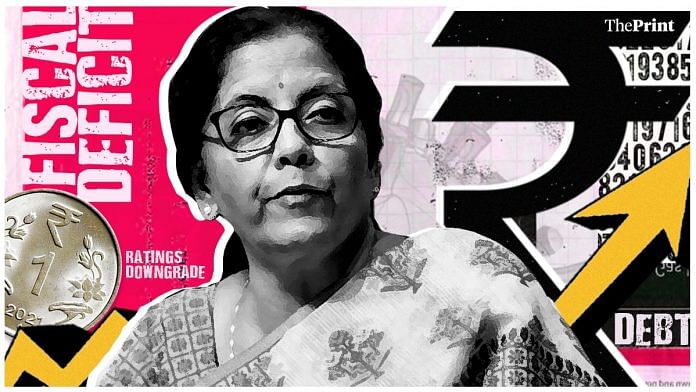The Narendra Modi government has announced a set of measures to provide relief to sectors adversely impacted by the second wave of the Covid-19 pandemic.
The structure of the relief indicates that the Government of India had an eye on the fiscal deficit while making the package.
It is that time of the year when credit rating agencies are looking carefully at four big numbers: the government’s borrowing, GDP growth, interest rates and inflation. The one number directly in the hands of the government is the fiscal deficit. Keeping it in control while trying to give GDP growth a push is a tightrope walk.
The package Finance Minister Nirmala Sitharaman announced this week raised the fiscal deficit by less than one per cent of GDP while increasing contingent liabilities of the government i.e. the Centre has to pay the credit that it is guaranteeing only if borrowers don’t pay up.
While the bulk of the stimulus package is in the form of credit guarantees, some measures were announced to support farmers and the poor.
The government’s decision to provide an additional subsidy of Rs 14,775 crore would support farmers’ income at a time when farm input prices are escalating. Moreover, the scheme of providing free foodgrains to the poor will be extended till November.
These two schemes along with the decision to spend on public healthcare will likely have a small impact on the fiscal deficit.
Also read: Special GST council session soon to discuss compensation-related issues, says Sitharaman
The package
Most of the measures announced are in the form of guaranteed credit. The highest priority is given to improving the state of health infrastructure in the country.
The government has announced Rs 1.1 trillion worth of loan guarantee for Covid-affected sectors. As part of the scheme, the health sector will get Rs 50,000 crore loan guarantee with a cap on interest rate from investments in health infrastructure in non-metro cities.
An additional allocation has been made for ramping up the public health sector with a primary focus on paediatric care. The remaining Rs 60,000 crore could be used by travel agencies and tourist guides. This would provide relief to the tourism sector.
The government has extended the guaranteed credit scheme (ECLGS) for small industries by Rs 1.5 trillion. This is to aid the small businesses facing cash flow shortage due to the disruption caused by the pandemic.
Data on bank credit shows that since the inception of the scheme for guaranteed credit, the credit flow to small and medium industries has improved. This move will not have an adverse impact on the balance-sheets of banks as the loans are fully guaranteed.
The loan guarantee scheme for the micro-finance institutions (MFIs) will further augment the flow of credit to the bottom of the pyramid borrowers. Since the loans are guaranteed, banks will have the comfort to lend to MFIs who could then lend to small borrowers.
Also read: Modi govt seen missing fiscal deficit target for 5th year due to Covid relief, weak revenues
Fiscal deficit concerns
The fiscal deficit for the fiscal that ended 31 March came in at 9.3 per cent of GDP (as against a revised estimate of 9.5 per cent) on the back of higher spending due to the pandemic.
The government has set a five-year fiscal consolidation roadmap from 9.5 per cent of GDP in 2020-21 to 4.5 per cent by 2025-26.
The debt of the central government has risen to 58.8 per cent of GDP as of March 2021 end from 51.6 per cent a year ago as the pandemic forced the government to borrow more to meet its expenditure commitments amid a decline in revenues.
The general government debt rose to 90 per cent of GDP. The rise has raised concerns over debt sustainability.
Ratings outlook
The second wave prompted many rating agencies to cut their growth forecasts in recent weeks. For instance, S&P lowered its growth forecast for the current fiscal year to 9.5 per cent from 11 per cent estimated earlier.
Rating agencies typically focus on medium-term fiscal finances. Some rating agencies have flagged concerns over the government’s fiscal roadmap, which they perceive to be more gradual than they had expected. Recently, S&P laid down conditions for India’s rating to be upgraded or downgraded, while maintaining a stable outlook.
India’s strong external sector will act as a buffer, but the agency cautioned that it may downgrade India’s rating if the economy recovers slowly, and if the government’s deficits and debts exceed their projections.
Any ratings downgrade could deter foreign investments into the country. It could potentially increase the cost of debt, which will further shrink the space for productive expenditures by the government.
Ila Patnaik is an economist and a professor at National Institute of Public Finance and Policy.
Radhika Pandey is a consultant at NIPFP.
Views are personal.
Also read: How soaring petrol, diesel prices pose threat to India’s recovery and inflation



